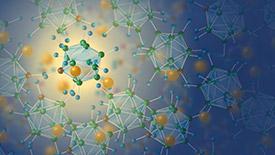

07/26/2021

© 2021 Kazuaki Kisu and Shin-ichi Orimo
A collaboration between AIMR, the Institute for Materials Research at Tohoku University, and the Laboratory of Materials for Renewable Energy at École Polytechnique Fédérale de Lausanne has designed, synthesized, and tested a new fluorine-free calcium monocarborane (Ca[CB11H12]2) electrolyte1. With improved conductivity and electrochemical stability, the new electrolyte is a significant step towards realizing rechargeable calcium batteries.
Calcium batteries are prime candidates for replacing their lithium-ion counterparts because of calcium’s abundance, non-toxicity, lower reduction potential compared to Mg or Al, and higher (Ca2+) ionic charge capacity compared to that of Li+.
However, the lack of a suitable electrolyte hinders the realization of calcium batteries with the above advantages.
Currently, cutting-edge model calcium batteries use fluorine-containing, weakly-coordinating electrolytes (e.g., Ca(BF4)2 or Ca(B[hfip]4)2 (hfip = hexafluoroisopropyloxy) in organic solvents) to maximize Ca2+ conductivity at the expense of electrochemical stability. Moreover, the presence of fluorine also results in the formation of a passivating CaF2 film that prevents the reversible calcium plating/stripping at the anode surface.
To address these challenges, the team led by Kazuaki Kisu (currently affiliated to the Institute for Materials Research) and Shin-ichi Orimo from AIMR has designed a new electrolyte using monocarborane counterions (icosahedrons in Figure). Like the Ca(BF4)2 example, the new counterion is a weakly coordinating anion that maximizes Ca2+ conductivity; but unlike Ca(BF4)2, it is free from CaF2 film forming.
“The monocarborane cluster is a stable, weakly coordinating counterion, but it is not soluble in many solvents,” says Kisu. “We overcame this problem by using a mixture of desired solvents at specific ratios.”
In this way, the team has synthesized the new electrolyte using a known scalable route. Preliminary tests of the electrolyte performances show promising results including high conductivity, wide electrochemical window, and reversible calcium plating/stripping without CaF2 film formation.
“The test results from the new monocarborane electrolyte open a new path for other multivalent rechargeable-battery systems,” says Orimo. “We are currently exploring the inclusions of other metals such as magnesium and aluminum.”
(Author: Patrick Han)
This research highlight has been approved by the authors of the original article and all information and data contained within has been provided by said authors.